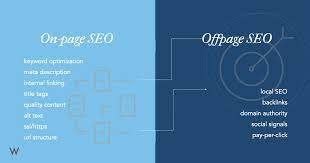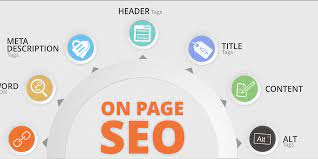On-Page Optimization: Boosting Your Website’s Performance
When it comes to improving your website’s visibility and ranking on search engine result pages (SERPs), on-page optimization plays a crucial role. On-page optimization refers to the practice of optimizing individual web pages to enhance their search engine friendliness and provide a better user experience. By implementing effective on-page optimization techniques, you can attract more organic traffic, engage visitors, and ultimately achieve your online goals.
The Key Elements of On-Page Optimization
Title Tags:
The title tag is an HTML element that defines the title of a webpage. It is displayed as the clickable headline in SERPs and should be concise, descriptive, and relevant to the content of the page. Including targeted keywords in your title tags can help search engines understand what your page is about.
Meta Descriptions:
A meta description provides a brief summary of the webpage’s content. Although it doesn’t directly impact rankings, it influences click-through rates (CTRs) by enticing users to click on your link. Craft compelling meta descriptions that accurately represent your page and encourage users to visit.
URL Structure:
A clean and descriptive URL structure helps both search engines and users understand what a page is about. Include relevant keywords in your URLs while keeping them concise and readable.
Heading Tags:
Heading tags (H1-H6) are used to structure the content hierarchy on a webpage. The H1 tag represents the main heading, while subsequent tags indicate subheadings. Properly using heading tags not only improves readability but also helps search engines comprehend the organization of your content.
Keyword Optimization:
Selecting relevant keywords for each webpage and strategically incorporating them into the content can improve your website’s visibility for those specific search terms. However, it’s important to maintain a natural flow and avoid keyword stuffing, which may lead to penalties from search engines.
High-Quality Content:
Creating valuable, informative, and engaging content is essential for on-page optimization. Search engines prioritize websites that provide users with high-quality content that answers their queries. Focus on delivering unique content that is well-researched, properly formatted, and easy to read.
Image Optimization:
Optimizing images by using descriptive filenames, alt tags, and compressing file sizes can improve page load times and enhance user experience. Additionally, properly optimized images can appear in image search results, driving additional traffic to your website.
The Benefits of On-Page Optimization
Implementing effective on-page optimization techniques offers several advantages:
- Improved Search Rankings: By optimizing various on-page elements, you increase the chances of ranking higher on SERPs for relevant keywords.
- Increase in Organic Traffic: Enhancing your website’s visibility in search results attracts more organic traffic from users actively searching for related information or products/services.
- Better User Experience: On-page optimization ensures that your webpages are user-friendly, easy to navigate, and provide valuable content that keeps visitors engaged.
- Increase in Conversions: An optimized webpage can lead to higher conversion rates as it effectively communicates your message and encourages users to take desired actions (e.g., making a purchase or submitting a form).
- Growth of Brand Authority: Consistently providing valuable on-page content positions your brand as an authoritative source in your industry, fostering trust and credibility among users.
Conclusion
On-page optimization is a critical aspect of any successful SEO strategy. By paying attention to the key elements mentioned above, you can improve your website’s performance, attract more organic traffic, and provide an exceptional user experience. Remember to regularly monitor and update your on-page optimization efforts to stay ahead of the competition and maintain a strong online presence.
6 Essential On-Page SEO Tips to Boost Your Website’s Search Engine Ranking and User Experience
- 1. Use relevant keywords in your page title and headings to improve search engine visibility.
- 2. Optimize your website’s loading speed by compressing images and minimizing code.
- 3. Create unique and descriptive meta tags for each page to improve click-through rates.
- 4. Structure your content with proper headings (H1, H2, etc.) for better readability and SEO.
- 5. Include internal links within your content to help search engines crawl and index your site effectively.
- 6. Optimize your images by using descriptive alt tags and reducing file sizes for faster loading.
1. Use relevant keywords in your page title and headings to improve search engine visibility.
Using relevant keywords in your page title and headings is a crucial tip for on-page optimization. By incorporating targeted keywords into these elements, you can significantly improve your website’s search engine visibility. Search engines rely on these tags to understand the context and relevance of your content. Including relevant keywords not only helps search engines identify the main focus of your page but also increases the chances of attracting organic traffic from users searching for those specific terms. By implementing this tip, you can enhance your website’s visibility and ultimately drive more targeted traffic to your site.
2. Optimize your website’s loading speed by compressing images and minimizing code.
To enhance your website’s loading speed, it is crucial to optimize it by compressing images and minimizing code. Large image files can significantly slow down your website’s loading time, causing frustration for visitors and potentially leading to higher bounce rates. By compressing images without compromising their quality, you can reduce file sizes and improve loading speed. Additionally, minimizing unnecessary code, such as removing whitespace or comments, can further optimize your website’s performance. Ensuring fast loading speeds not only enhances the user experience but also positively impacts search engine rankings, as search engines prioritize websites that provide a seamless browsing experience.
3. Create unique and descriptive meta tags for each page to improve click-through rates.
Creating unique and descriptive meta tags for each page is a crucial tip for on-page optimization. Meta tags, specifically the meta description, provide a concise summary of the webpage’s content in search engine results. By crafting compelling and relevant meta tags, you can significantly improve click-through rates (CTRs). When users see a well-written meta description that accurately represents the page’s content, they are more likely to click on your link. This not only increases organic traffic to your website but also enhances user engagement and improves overall search engine visibility. Remember to carefully tailor your meta tags to each specific page, incorporating targeted keywords and enticing language that encourages users to visit your site.
4. Structure your content with proper headings (H1, H2, etc.) for better readability and SEO.
Structuring your content with proper headings, such as H1, H2, and so on, is a crucial tip for on-page optimization. These heading tags not only improve the readability of your content by organizing it into logical sections but also play a significant role in search engine optimization (SEO). Search engines rely on heading tags to understand the hierarchy and relevance of your content. By using appropriate headings, you can help search engines better comprehend your page’s structure and keywords, ultimately boosting your SEO efforts. Additionally, well-structured headings make it easier for users to skim through your content and find the information they need, enhancing their overall experience on your website.
5. Include internal links within your content to help search engines crawl and index your site effectively.
Including internal links within your content is a valuable on-page optimization technique that can greatly benefit your website’s search engine visibility. By strategically linking to other relevant pages within your site, you provide search engines with clear pathways to crawl and index your content effectively. Internal linking not only helps search engines understand the structure and hierarchy of your website but also improves user navigation, allowing visitors to discover more valuable information. By incorporating internal links throughout your content, you enhance the overall user experience and increase the chances of higher rankings on search engine result pages.
6. Optimize your images by using descriptive alt tags and reducing file sizes for faster loading.
A crucial tip for on-page optimization is to optimize your images by using descriptive alt tags and reducing file sizes for faster loading. Alt tags provide alternative text descriptions for images, helping search engines understand their content and improving accessibility for visually impaired users. By using descriptive alt tags that accurately describe the image, you enhance the relevance of your webpage and increase the chances of appearing in image search results. Additionally, reducing file sizes through compression techniques ensures that your webpages load quickly, providing a better user experience and reducing bounce rates. Optimizing images not only improves SEO but also contributes to overall website performance.



